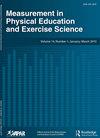EasyForce测力仪评估膝关节和髋关节最大力量的可靠性,并与外固定的刚性等距测力仪进行比较
IF 1.9
4区 教育学
Q2 EDUCATION & EDUCATIONAL RESEARCH
Measurement in Physical Education and Exercise Science
Pub Date : 2021-12-28
DOI:10.1080/1091367X.2021.2019037
引用次数: 3
摘要
摘要本研究旨在评估一种新型EasyForce测功机的访视内和访视间可靠性,该测功机用于评估膝盖伸展和屈曲以及髋关节外展和内收任务中的最大力量。年轻健康参与者(n=50;25名男性,25名女性;年龄:23.4±2.1岁)在两个疗程(间隔5-10天)中使用EasyForce测功机和带外固定的刚性等长测功机测量最大关节扭矩。访视内可靠性高(ICC)=0.84–0.95膝关节;0.90–0.94髋关节),绝对可靠性有时超过可接受的阈值(CV=6.9–10.6%膝关节;7.8–11.8%髋关节)。所有任务的访视间可靠性都很好(ICC=0.95–0.97膝关节;0.95–0.96髋关节)。尽管EasyForce值与刚性测力计不同,但设备之间的相关性很高(r=0.64–0.75膝盖;0.70–0.75髋关节)。总之,EasyForce测功机提供了评估膝关节(伸展和屈曲)和髋关节(外展和内收)肌肉力量的可靠方法。本文章由计算机程序翻译,如有差异,请以英文原文为准。
Reliability of EasyForce Dynamometer for Assessment of Maximal Knee and Hip Strength, and Comparison to Rigid Isometric Dynamometers with External Fixation
ABSTRACT This study aimed to assess intra- and inter-visit reliability of a novel EasyForce dynamometer for assessment of maximal strength in knee extension and flexion, and hip abduction and adduction tasks. Young healthy participants (n = 50; 25 males, 25 females; age: 23.4 ± 2.1 years) were measured for maximal joint torque with EasyForce dynamometer and rigid isometric dynamometers with external fixation, in two-sessions (5–10 days apart). The intra-visit reliability was high (ICC) = 0.84–0.95 knee; 0.90–0.94 hip), with absolute reliability sometimes exceeding the acceptable threshold (CV = 6.9–10.6% knee; 7.8–11.8% hip). Inter-visit reliability was excellent for all tasks (ICC = 0.95–0.97 knee; 0.95–0.96 hip). Although the EasyForce values were different compared to rigid dynamometers, the correlations between the devices were high (r = 0.64–0.75 knee; 0.70–0.75 hip). In conclusion, the EasyForce dynamometer provides reliable means of assessing knee (extension and flexion) and hip (abduction and adduction) muscle strength.
求助全文
通过发布文献求助,成功后即可免费获取论文全文。
去求助
来源期刊

Measurement in Physical Education and Exercise Science
Medicine-Orthopedics and Sports Medicine
CiteScore
4.20
自引率
33.30%
发文量
24
期刊介绍:
The scope of Measurement in Physical Education and Exercise Science (MPEES) covers original measurement research, special issues, and tutorials within six substantive disciplines of physical education and exercise science. Six of the seven sections of MPEES define the substantive disciplines within the purview of the original research to be published in the journal: Exercise Science, Physical Activity, Physical Education Pedagogy, Psychology, Research Methodology and Statistics, and Sport Management and Administration. The seventh section of MPEES, Tutorial and Teacher’s Toolbox, serves to provide an outlet for review and/or didactic manuscripts to be published in the journal. Special issues provide an avenue for a coherent set of manuscripts (e.g., four to five) to collectively focus in-depth on an important and timely measurement-related issue within the scope of MPEES. The primary aim of MPEES is to publish high-impact manuscripts, most of which will focus on original research, that fit within the scope of the journal.
 求助内容:
求助内容: 应助结果提醒方式:
应助结果提醒方式:


